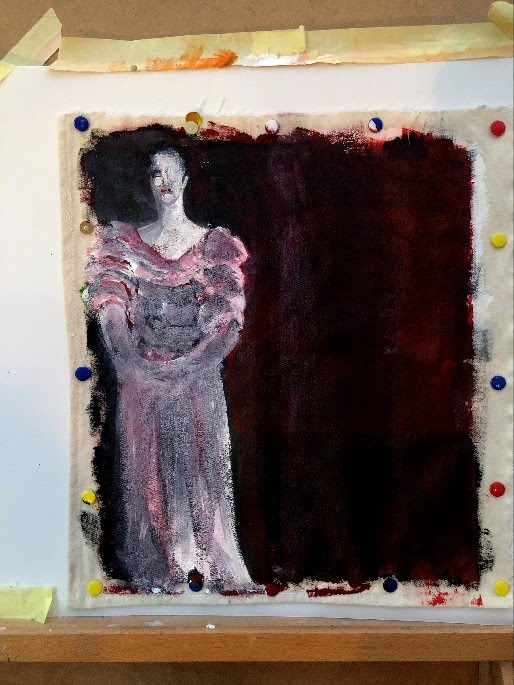In the absence of any possibility of a live model, I looked through a number of art books with good colour plates to find a substitute. The one that drew my eye, largely because of the sullen expression of the central figure which put me in mind of every teenage girl anywhere made to stand wearing her not-favourite-dress while her dad took his prideful photo. This young woman was in a huff and that huff was going to be immortalised. The painting, My Children (Mary, Gerald and Gladys Thayer) was painted by their father – yes, it really is that snapshot – Abbott Handerson Thayer in 1897, and I found it in Juliette Aristides’ Lessons in Classical Painting (2016, p 30). I had half an intention of trying to make a copy but instead subverted it to the prevailing mood which is less sulk than anger and worldwide social isolation*
Sometime earlier, I had prepared an off-cut of duck cotton with transparent gesso followed by strips of three different shades of red acrylic. As that was a while ago, I can’t recall which these were. The colour suited the anger and outrage at the position we find ourselves in, and the pale white of the woman’s skin and dress in the centre seemed to reflect both the innocence of the populations caught up in it and also the shrouds so many are now being wrapped in. I used again a limited palette, this time of titanium white, Payne’s grey, Alizarine crimson, and sap green.
The first iteration was bulky and misshapen although I liked what had happened to the head which, due to failing to get the left eye (on the right) anywhere near acceptable, had become Borgian. I closed her other eye too – she is not looking, doesn’t want to see what is going on.

I also placed her up against the left margin of the support with thoughts of representing isolation through the juxtaposition of confinement and emptiness. At this point, I really didn’t have much of an idea where I might be going though.
After a day or so of looking at it, doing something else and looking again, the representation changed. I wanted to take the frills down a notch, to realign her body and to use what in the original is a dark tree in the background to make a cloud of dark hair, rather in the pre-Raphaelite style. It was there by accident.

This iteration uses very dilute wash on a white base to make the shadows and folds of the dress, and adds a sap green/Payne’s grey mix over the dry white brushed onto the first red layer. I used a piece of old towel to dab this while it was wet, making the splintered light in the green background. In fact this reflects the original somewhat as it is greenish, if you exclude the two siblings in the tableau, which I have.
I needed to make some adjustments to her arms and to that left eye but left it to settle for a little, while keeping my own eye on it.
The next day I made some tiny adjustments, including a version of the laurel wreath this poor girl is holding. If I had more skill, this would be watercress which has a good deal more currency than laurel at the moment.

As usual, I haven’t managed to fit the figure into the space and I can’t pretend I meant to cut her off short at the feet. I do think it fulfils the brief of atmosphere and mood, and to me it has the feel of glass plate photography. I have pictures of my great grandparents printed from such plates, and inherited the plates themselves when my parents died. No wonder people thought they saw ghosts and ectoplasmic manifestations in those images.
Aristides, J. 2016. Lessons in Classical Painting. Watson-Guptill. P 30.
*As I write this, the UK is at the beginning of a weeks’ long lockdown due to the rapid spread of coronavirus.
Time taken: approx 6 hours.
Learning outcomes 1, 2, 3, and 4. For me, LO1 is met by re-using an existing support already painted and by trying to make a copy/translation of an existing work of art. LO2 I think, is illustrated by my adaptation of the original composition and use of additional methods, such as flannel, to achieve the ends. LO3 is referenced via the Aristides book which I had been working through, along with her Drawing atelier, and via the search for a suitable image from historical art to substitute for a model. LO4 is exemplified by my contemporaneous narrative which I use for my own benefit but which also harks back to my background in science where the method is meticulously laid out so that an experiment can be replicated by others.

Wow well done. Your voice is definitely becoming apparent now.
LikeLiked by 1 person
Thanks, I’m beginning to feel a bit more in charge of this weird art machine – driving it rather than clinging onto the steering as it careers ahead out of control!
LikeLike